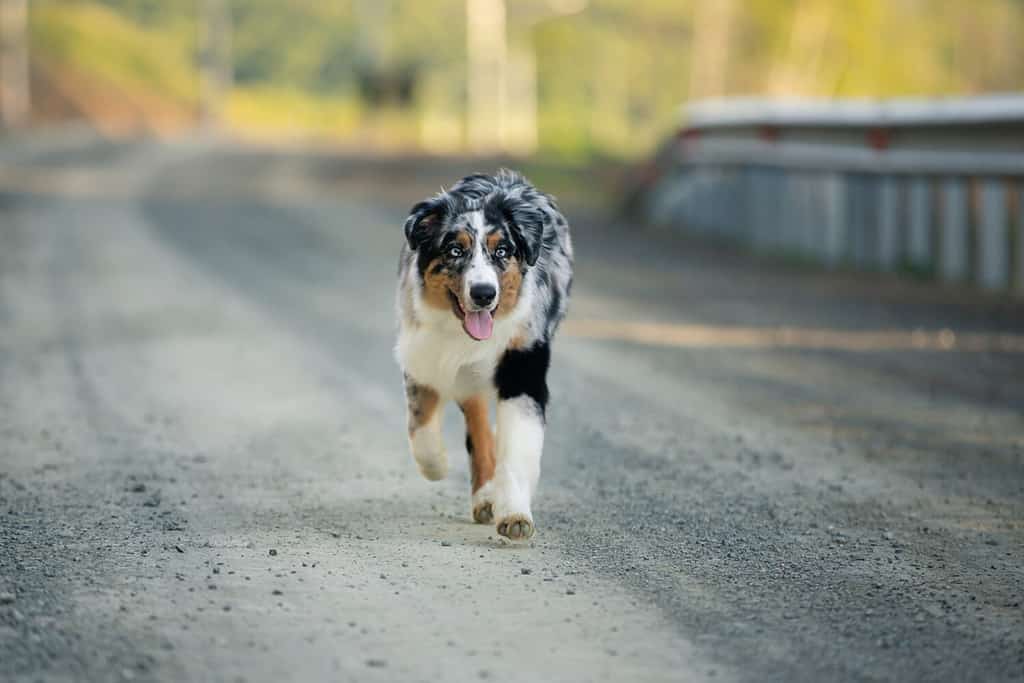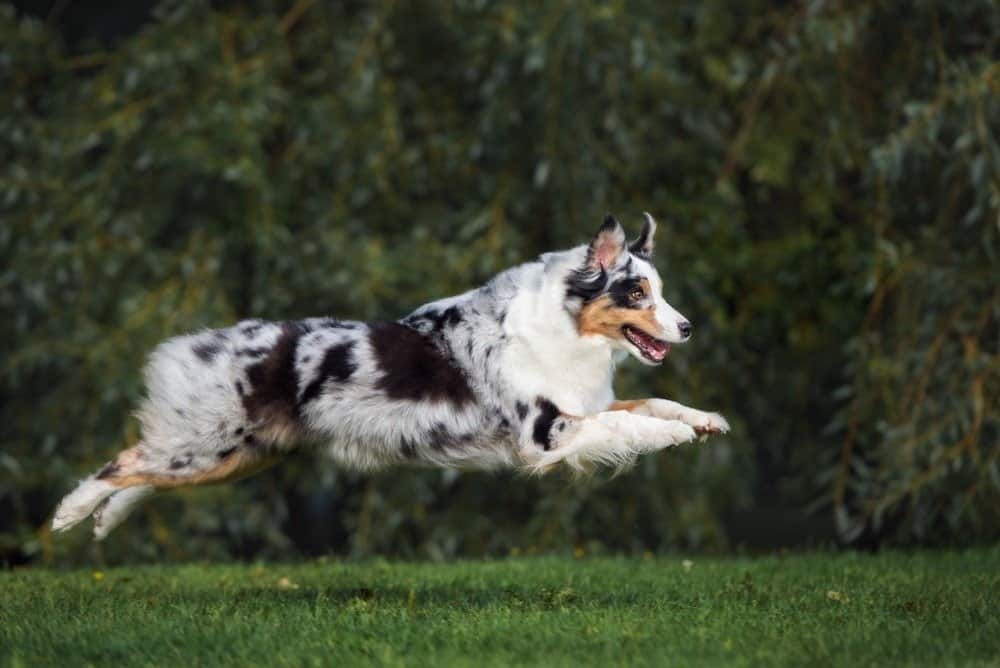Australian Shepherd pregnancy is an exciting and rewarding journey for pet owners and their beloved dogs. As a breed known for its intelligence, agility, and loyalty, new puppies bring joy and curiosity. This comprehensive guide will walk you through the gestation period, weekly milestones, and care tips for a healthy and happy pregnancy for your Aussie.
From conception, your Australian Shepherd’s pregnancy will last approximately 63 days. During this time, monitoring her health and well-being and preparing for the puppies’ arrival is crucial. You’ll witness your furry friend’s body change and grow each week, nurturing the tiny lives inside her.
To make this journey as smooth as possible, we’ve compiled essential information on what to expect each week and several vital care tips to support your Aussie’s pregnancy. From dietary adjustments to exercise routines, our guide is here to help you every step of the way.
Join us as we delve into Australian Shepherd pregnancy. Prepare to welcome a litter of energetic, intelligent, and adorable puppies into your life.
Overview: Australian Shepherd
Meet the Australian Shepherd, a loyal and energetic breed. Despite its name, this breed originates from the United States. They were bred for herding livestock and are known for their intelligence and agility.
Australian Shepherds boast thick, wavy coats in colors like blue or red merle, black, and red. Their eyes can be brown or blue.
Training your Aussie is a breeze, thanks to their high intelligence. Consistent, positive reinforcement works wonders with this breed. Early socialization is crucial to ensure they become well-rounded adults.
Aussies need plenty of exercise to stay happy and healthy. A daily walk or run, coupled with mental stimulation, will keep your furry friend satisfied. Remember, a bored Aussie can become destructive, so keep them engaged.
Australian Shepherds form strong bonds with their families. They’re protective, making them excellent watchdogs. But don’t worry, they’re also friendly and get along well with children and other pets.
The Australian Shepherd is a perfect companion for active individuals and families. Their intelligence, loyalty, and stunning appearance make them truly exceptional.

Australian Shepherds need plenty of exercise to stay happy and healthy. A bored Aussie can easily be destructive.
©Anastasiia Cherniavskaia/Shutterstock.com
Australian Shepherd Pregnancy Symptoms and Signs
Once your Aussie is bred, you’ll want to watch for signs and symptoms of pregnancy. Your vet can also confirm the pregnancy with an ultrasound or blood test. Australian Shepherd pregnancy signs include:
Behavioral Changes
You might observe a decline in your dog’s usual activity in the early stages of an Australian Shepherd pregnancy. Fatigue often sets in, accompanied by nausea-like symptoms similar to morning sickness in humans.
Fortunately, once the initial tiredness fades, your pregnant Australian Shepherd typically regains normal energy levels until the end of the pregnancy, when increased weight demands more rest.
As labor nears, your Australian Shepherd may become restless instead of weary. It’s natural for her to look forward to the end of her pregnancy. Watch for these behavioral changes and consult your veterinarian to ensure a healthy, happy pregnancy journey for your furry friend.
Increased Appetite
Australian Shepherd pregnancy is characterized by increased appetite, often around the halfway point, when a dog’s caloric needs rise.
Until then, continue providing a well-balanced adult diet. Avoid overfeeding in the first 30 days, as it can negatively affect pregnancy safety. Once you reach the midway point, consult your veterinarian about transitioning to an all-life-stages dog food for extra nourishment.
Be cautious not to overfeed; increase food intake by 25% weekly during the final four weeks. Refrain from adding extra nutrients like calcium, as the recommended diet already includes essential vitamins and minerals.
Early pregnancy stages may seem normal, with physical symptoms appearing after halfway. Stay aware of potential health issues. Around three weeks into pregnancy, hormonal changes may cause stomach discomfort, reduced appetite, or vomiting.
Similar to human morning sickness, these symptoms typically resolve within a week. However, if your dog refuses to eat or experiences prolonged symptoms, consult a veterinarian to rule out severe problems. Keep a watchful eye on your pregnant Australian Shepherd and enjoy this unique experience together.

Increase food intake by 25% weekly during the final four weeks refraining from adding nutrients like calcium.
©Jan Havlicek/Shutterstock.com
Enlarged Nipples
Enlarged nipples are a common early sign of pregnancy in Australian Shepherds. It appears two to four weeks into the pregnancy. This change in your dog’s nipples results from hormonal fluctuations as her body prepares for nursing puppies. While this symptom alone doesn’t confirm pregnancy, it indicates that your Australian Shepherd may be expecting.
Post-mating, she could produce a small amount of vulva mucus, signaling the beginning of her pregnancy journey. Her teats may enlarge and turn pink during this period. It’s not uncommon for a bit of fluid to leak occasionally. These changes indicate that your dog’s body adapts to nurture and care for her soon-to-be-born puppies.
Weight Gain
During Australian Shepherd pregnancy, weight gain is a common occurrence. Your dog’s weight may increase by up to 50% starting around the seventh week. Please avoid overfeeding her during this time.
As your Aussie’s pregnancy progresses, her abdomen will naturally enlarge. This noticeable change often appears around day 40. Keep in mind that her belly size may vary based on several factors.
First-time mothers or those with smaller litters might see less abdomen expansion. By closely monitoring your dog’s weight and physical changes, you’ll be better equipped to provide proper care throughout her pregnancy.
Nesting Behavior
Nesting behavior is a key indicator of an Australian Shepherd’s pregnancy. As delivery time approaches, your dog will search for a quiet, comfortable spot to give birth. This behavior often involves gathering blankets or towels to create a cozy den.
To support your Australian Shepherd during this nesting period, provide her with a designated space. A whelping box or a specific area in your home works well. Ensure it is situated away from noise and distractions, allowing your dog to feel secure and relaxed.
Paying close attention to nesting behavior can help you identify if your Australian Shepherd is pregnant. You can better support your dog during this exciting time by providing a safe and comfortable environment. Remember to consult a veterinarian for advice on prenatal care and other pregnancy symptoms.

Paying close attention to nesting behaviors can help you identify if your dog is pregnant.
©Ryan Brix/Shutterstock.com
Australian Shepherd Gestation Period
Australian Shepherds, on average, give birth after 60 to 65 days. However, small variations of 2-3 days might occur. During the early stages of an Australian Shepherd pregnancy, it’s tough to notice changes in your dog’s health. Some may show apathy and sleepiness in the second or third week.
By around 25 to 30 days, the mammary glands become visible. They often display a bright pink hue due to nearby skin swelling. Since Australian Shepherds have white bellies, this change is easy to spot.
Three weeks after mating, ultrasonography can confirm pregnancy. Embryos inside amniotic bubbles are easily seen on an ultrasound machine. The following period is crucial for assessing fetal viability.
A complex blood serum test measuring the hormone relaxin concentration can diagnose pregnancy at an early stage.
Here is a detailed breakdown of everything that happens during the gestation period:
Week 1 – Mating & Fertilization
Week one of an Australian Shepherd pregnancy involves mating and fertilization. After mating, multiple eggs fertilize the upper uterus and migrate to the uterine horns.
During this stage, your Australian Shepherd experiences hormonal changes. However, since it’s the earliest phase of pregnancy, you won’t see any physical changes. Your dog should act normal unless complications arise. Continue engaging, playing, and feeding your canine as usual throughout this period.
Week 2 – Maintenance
Week two of your Australian Shepherd’s pregnancy is all about maintenance. You can continue grooming your pet as usual without worries. The embryos are safely tucked away in the uterus, so gentle grooming won’t cause complications.
During this week, focus on maintaining your dog’s weight. Let your Australian Shepherd gain at most 10% of its normal body weight until week 6. Your dog’s energy levels should remain consistent since the embryos aren’t growing rapidly.
In general, there’s no need to change your dog’s diet or add supplements at this stage of the Australian Shepherd pregnancy. However, always follow your vet’s recommendations if they suggest otherwise.

During the second week, grooming can continue as usual without worries about harming the embryos.
©Alpeek/Shutterstock.com
Week 3 – Nidation
In week three, the tiny puppies find protection. They nestle within a nourishing membrane, receiving essential nutrients for growth. No major physical changes occur, keeping the process discreet.
Your Australian Shepherd’s daily routine remains unchanged. However, a growing appetite emerges, signaling the need for extra food. Ensure you provide more to support your fur baby’s needs.
Week 4 – Confirm Pregnancy
In week four, around day 25, it’s time to visit your local veterinarian. Schedule an ultrasound for your Australian Shepherd. This crucial step also helps identify any abnormalities or complications needing attention.
Visiting a veterinarian will give you valuable insight into your dog’s pregnancy. Ultrasound provides a clear picture of what’s happening inside, ensuring your furry friend’s well-being.
Week 5 – Foetal Stage
This week marks the transition from embryogenesis to the fetal stage. Excitingly, the organs start developing in earnest now.
You’ll notice significant weight gain as your Aussie enters the fetal stage. It’s crucial to increase their food intake to support healthy fetal development. However, don’t just guess the amount; consult your veterinarian for expert advice.

During week 5, there’s significant weight gain; it’s crucial to increase their food intake to support healthy fetal development.
©otsphoto/Shutterstock.com
Week 6 – Turning Point
Week six marks a pivotal moment in the Australian Shepherd’s gestational period. The puppies develop distinct organs, tissues, and claws at this stage. Adjusting your dog’s diet with increased energy, protein, and minerals is crucial to support their growth.
However, don’t be alarmed if you notice a decline in appetite; this might be likely due to pregnancy discomfort. Keeping your dog well-nourished is essential during this period.
Week 7 – Hair Growth
In week seven, the Australian Shepherd puppies grow significantly. Their organs and tissues become more defined, and even their claws start to form.
Feeding your dog a diet rich in energy, protein, and minerals is crucial at this stage. Despite her reduced appetite due to gestational discomfort, ensure she receives enough nutrients for herself and her puppies.
Encourage your dog to eat the right foods by offering smaller, frequent meals throughout the day instead of two large ones. This approach alleviates discomfort and supports her ongoing pregnancy journey.
Week 8 – X-ray
As week eight unfolds, the puppies form more defined organs, tissues, and claws. Supplying your dog with ample nutrients for her and the pups’ well-being is vital. Enhance their diet with increased energy, protein, and minerals.
Despite these efforts, you might observe a decrease in appetite due to gestational discomfort. As emphasized, ensuring your dog consumes the right foods during this period is crucial.
Consider providing several smaller meals throughout the day rather than two larger ones to make it more manageable. This method will improve her appetite and support her nutrient intake for a healthy gestation. Monitor your Australian Shepherd’s diet as you anticipate her puppies’ arrival.

Consider providing several smaller meals throughout the day rather than two larger ones to make it more manageable.
©Michelle D. Milliman/Shutterstock.com
Week 9 – Delivery Time
During week nine of the Australian Shepherd’s gestation period, puppies develop distinct organs, tissues, and claws. It’s crucial to ensure your dog and her puppies receive ample nutrients by increasing their diet’s energy, protein, and minerals. Despite a possible dip in appetite due to pregnancy discomfort, proper nutrition remains vital.
Care for the Australian Shepherd during the Pregnancy
When your Australian Shepherd is expecting, regular checkups and nourishment are vital. Here are some tips to ensure a healthy pregnancy:
Proper Nutrition for Pregnant Aussies
Feed your pregnant Aussie high-quality dog food, preferably one designed for pregnancy and lactation. Increase her portions gradually as pregnancy progresses. Remember, a balanced diet is essential to the health of mothers and puppies.
Gentle Exercise and Mental Stimulation
Moderate exercise is vital during pregnancy, but avoid strenuous activities. Opt for gentle walks or light playtime instead. Additionally, provide mental stimulation with:
- Gentle walks
- Light playtime
- Puzzle toys
- Gentle training sessions

It’s important to engage in moderate exercise while avoiding strenuous activities. Opt for gentle walks or light playtime to maintain a healthy routine.
©Christian Mueller/Shutterstock.com
Grooming and Coat Maintenance
Maintain regular grooming sessions to keep your pregnant Aussie’s coat healthy. Brush her at least once a week, avoiding excessive pressure on the belly. Bathe her gently as needed, taking care not to stress her during the process.
Prenatal Health Checkups
Schedule regular prenatal vet visits to monitor your Aussie’s health throughout her pregnancy; this includes ultrasounds, blood tests, and parasite prevention. Discuss any concerns or questions with your veterinarian to ensure a smooth pregnancy.
Preparing for Whelping
Create a comfortable, quiet space for your Australian Shepherd to give birth. This area should be clean, warm, and free from distractions. Gather essential supplies such as towels, blankets, and a whelping box to make the process easier.
When Can Australian Shepherds Get Pregnant?
Australian Shepherds can get pregnant every 10 to 12 months during their estrus cycle. The fertile period, or estrus, lasts for up to three weeks.
Be cautious during this time to avoid unexpected litters of puppies. Share your dog’s reproduction issues with professionals, as having puppies can be costly and emotionally challenging. To prevent pregnancy, consider sterilizing your Australian Shepherd.

The Australian Shepherd’s reproductive cycle occurs every 10 to 12 months, with a fertile period lasting up to three weeks.
©cynoclub/Shutterstock.com
Nurturing New Life: Mastering Australian Shepherd Pregnancy and Care
Australian Shepherd pregnancy is a unique and exciting journey for the dog and its owner. With a gestation period of around 63 days, monitoring weekly milestones and providing proper care is essential for ensuring the health and well-being of the expectant mother and her puppies. By understanding the various stages of pregnancy and following a comprehensive care guide, owners can support their Australian Shepherd throughout this incredible process.
Regular checkups with a veterinarian, a balanced diet, and a comfortable and stress-free environment will all contribute to a successful pregnancy, culminating in a healthy litter of adorable Australian Shepherd puppies.
The photo featured at the top of this post is © Jithu B Mohan/Shutterstock.com
Ready to discover the top 10 cutest dog breeds in the entire world?
How about the fastest dogs, the largest dogs and those that are -- quite frankly -- just the kindest dogs on the planet? Each day, AZ Animals sends out lists just like this to our thousands of email subscribers. And the best part? It's FREE. Join today by entering your email below.
Thank you for reading! Have some feedback for us? Contact the AZ Animals editorial team.






